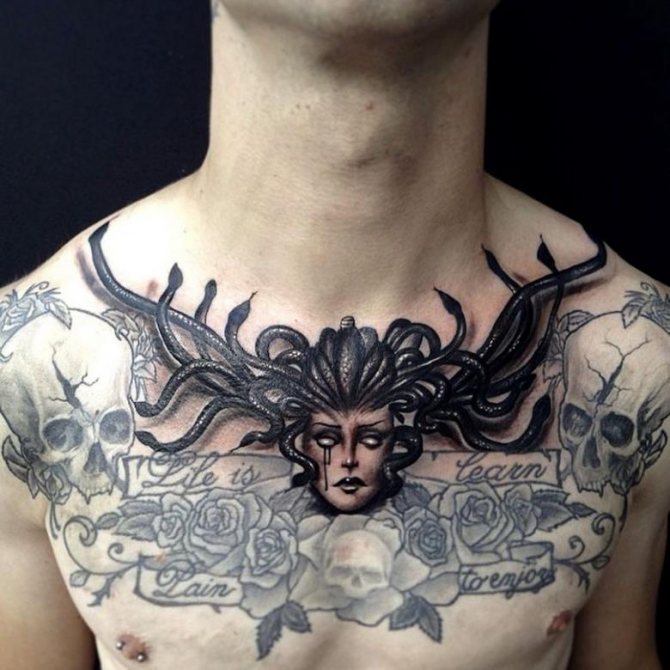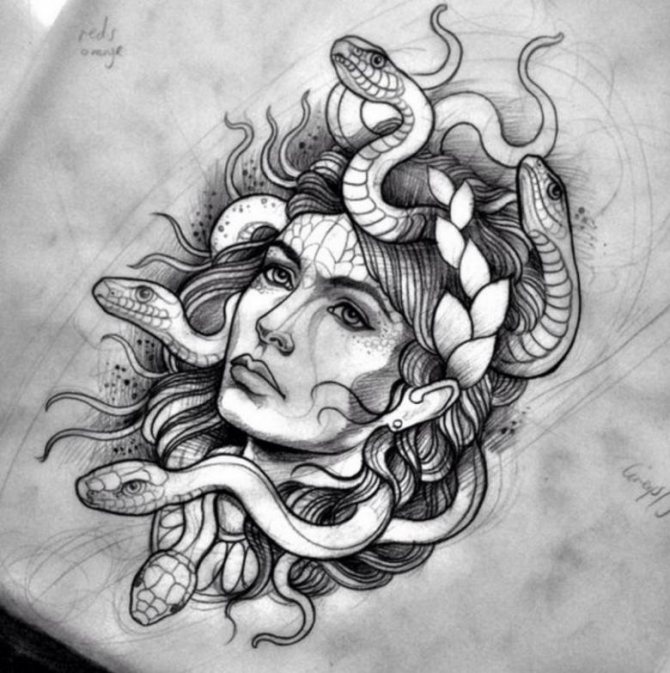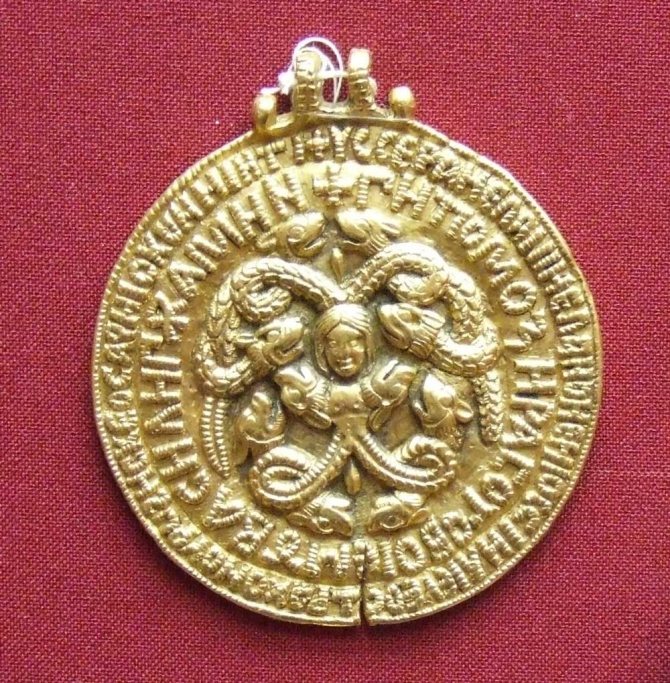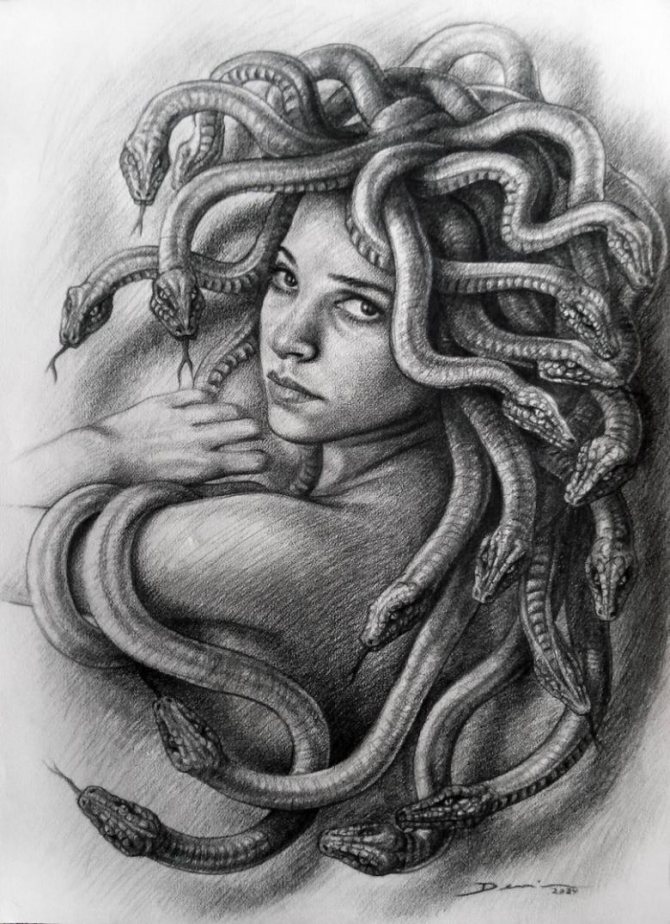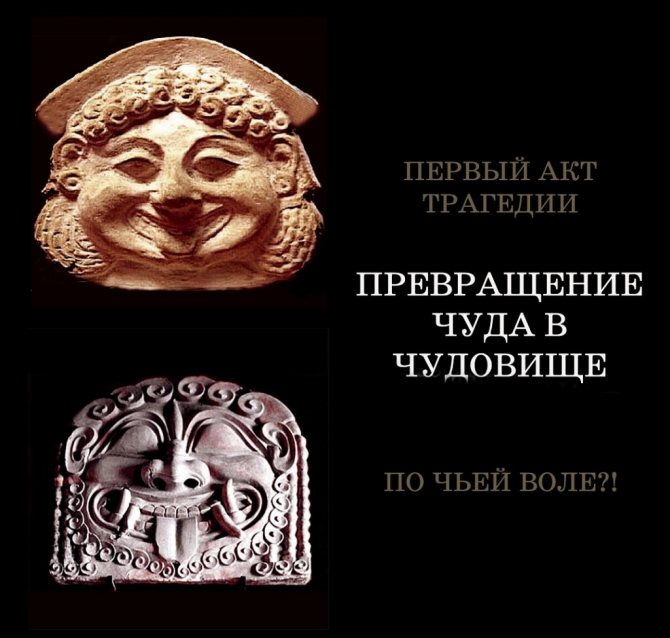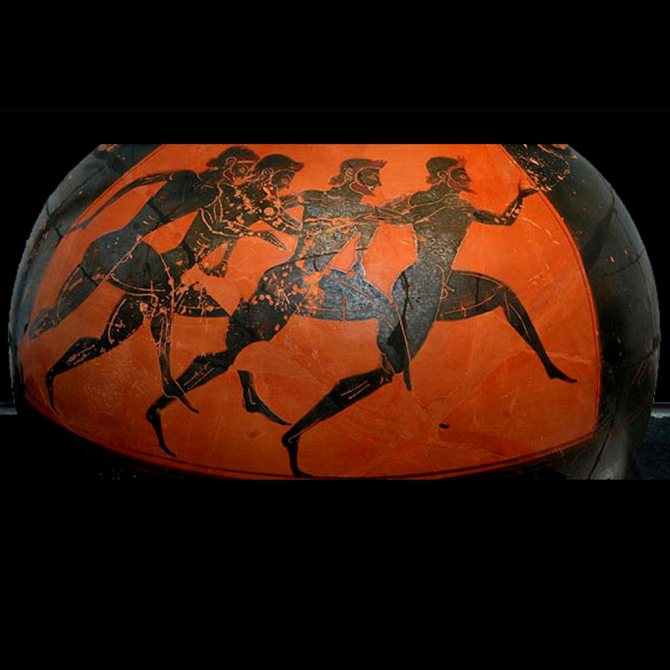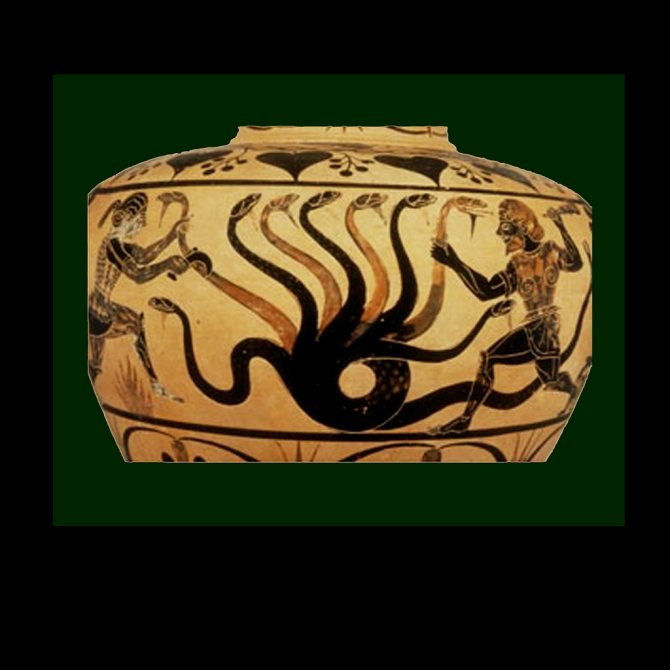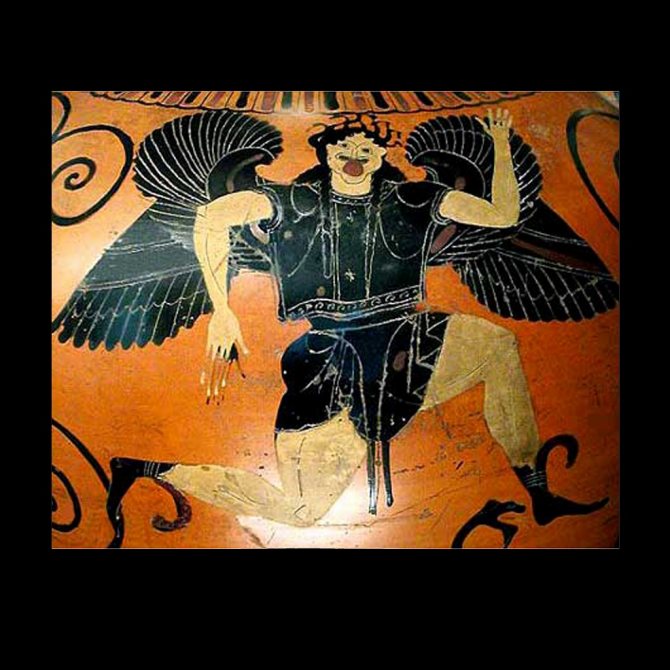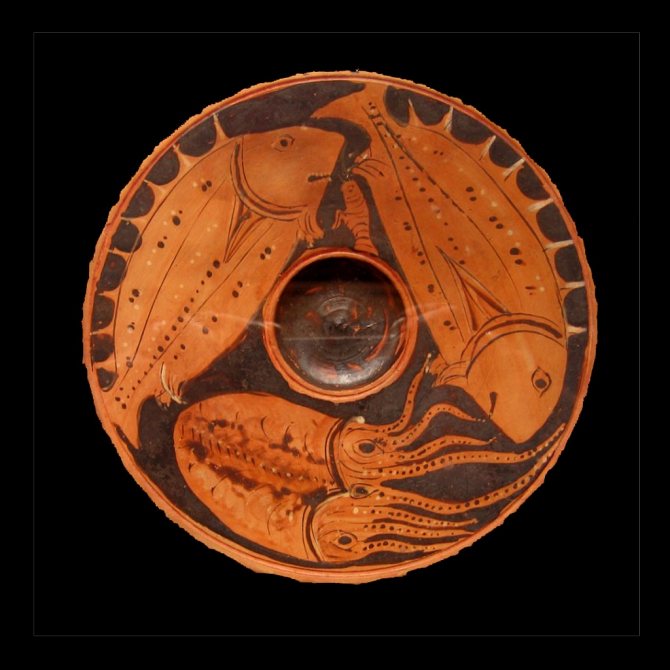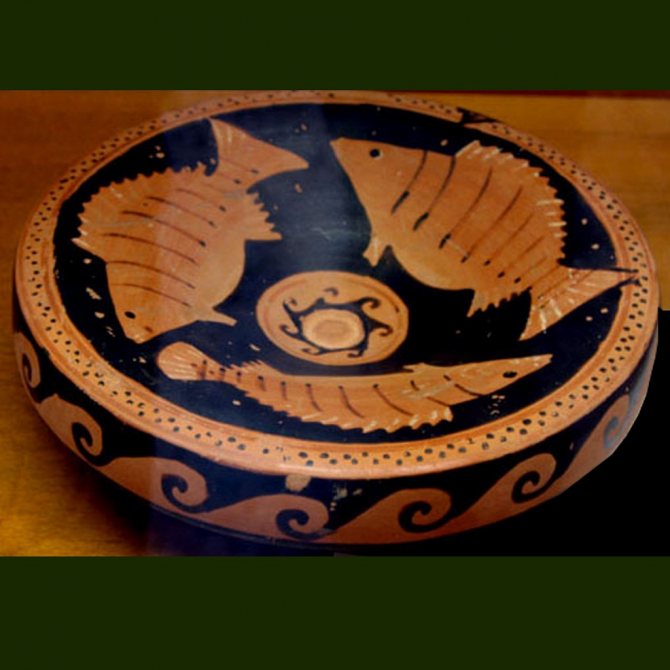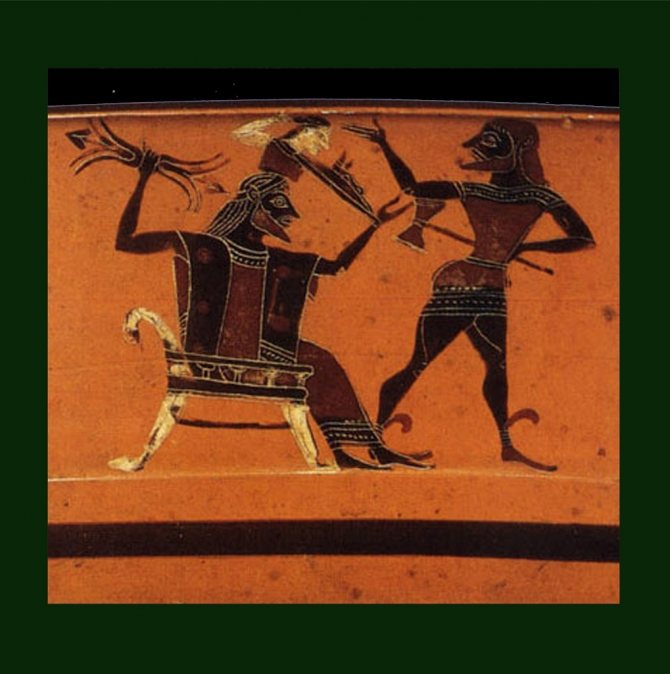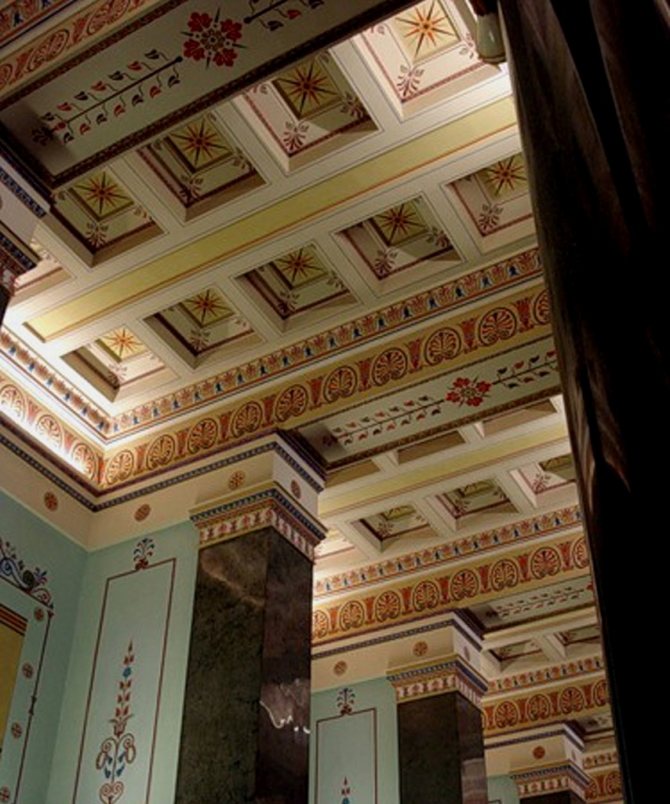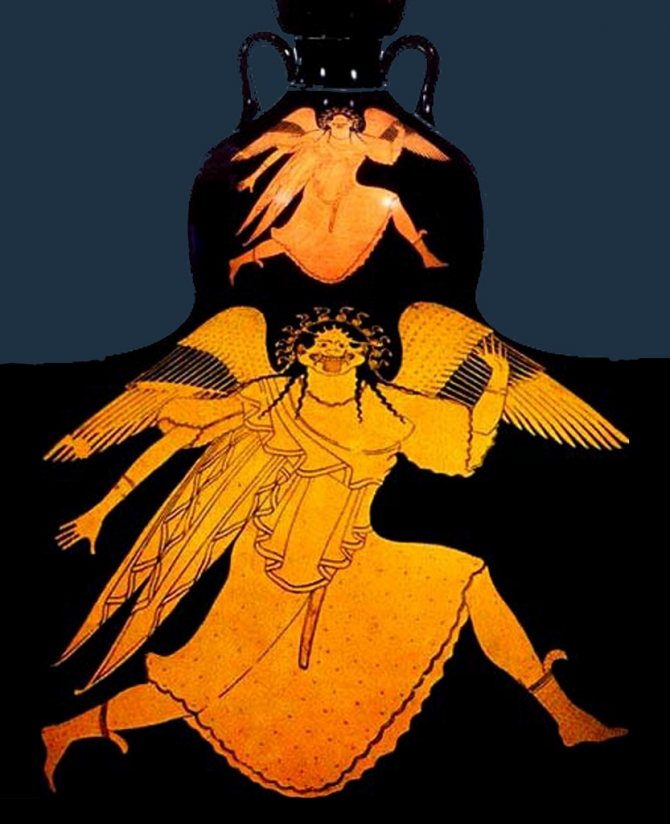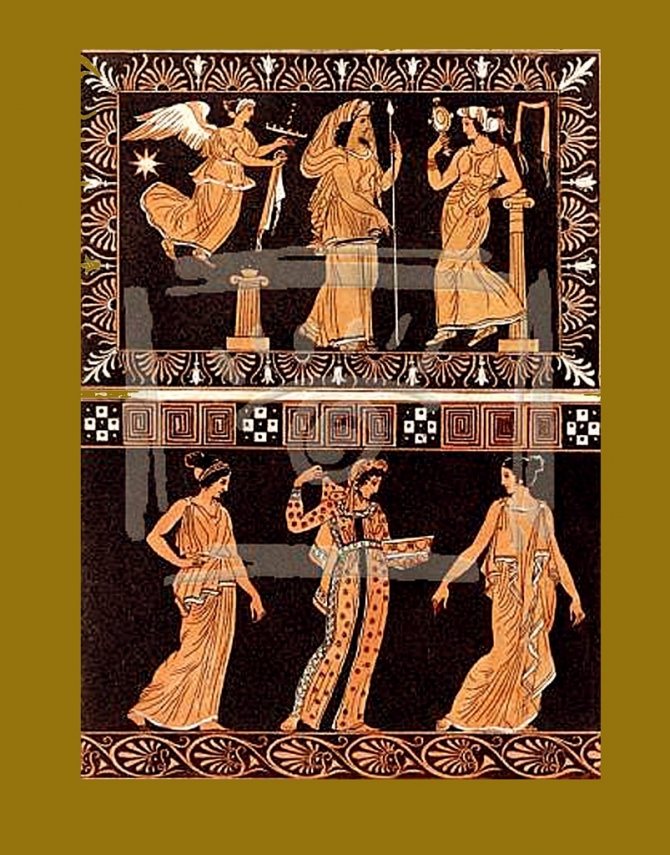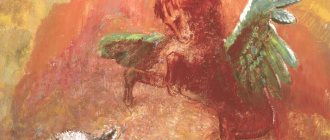Medusa Gorgon is a famous creature of ancient Greek lore.
We are used to imagine Medusa Gorgon as a terrible monster. This is how most of the known ancient Greek legends tell about her, but for some reason the myths of her origin and transformation have been relegated to the background. Can you imagine that once Medusa was one of the most beautiful girls in Greece? And that's exactly what she was.
As is often the case, the gods intervened in her fate, against which a mortal man is unable to resist. What does the life story of this strange heroine evoke: pity or contempt? Why did Medusa Gorgon take her horrible form?
The Three Beautiful Sisters
When the gods did not yet rule the world, the titans were powerful rulers over all living things. They lived both on earth and in the depths of the waters. The last were Phorkius and Keto, who had six children. Three of them already resembled old men from birth, they received the nickname Forcidas.
The other three daughters were of unearthly beauty, and were nicknamed Gorgons. Two of the beautiful sisters were immortal, and the youngest, Medusa, was the only mortal among the daughters of the titans.
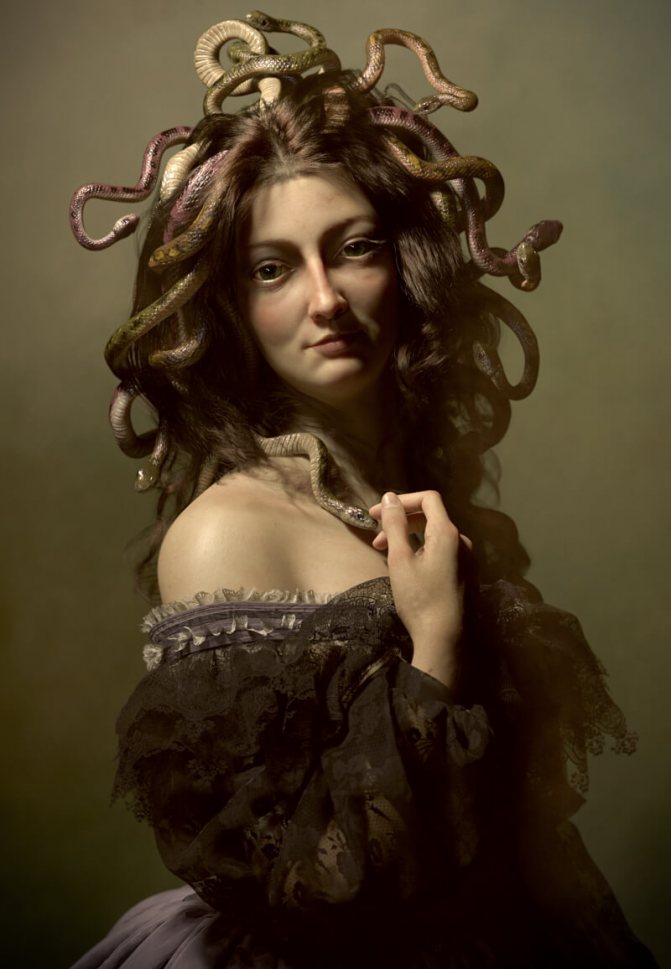
The beautiful Medusa Gorgon performed by Georgia Saroj of the United States / ggsaroj.artstation.com
Despite her peculiarity, which related her to mortal men, Medusa was the most beautiful among sea maidens. Her eyes shone like the summer sky and her hair resembled glittering waves of gold. No wonder the voluptuous Poseidon immediately turned his attention to the girl.
Who would be good for such a tattoo?
The Gorgon tattoo usually looks quite attractive. She is depicted with a cute face, a memorable look and a huge number of snakes instead of hair. Usually the image is made large, because a small picture can not convey any spectacular Medusa, or its enchanting gaze.
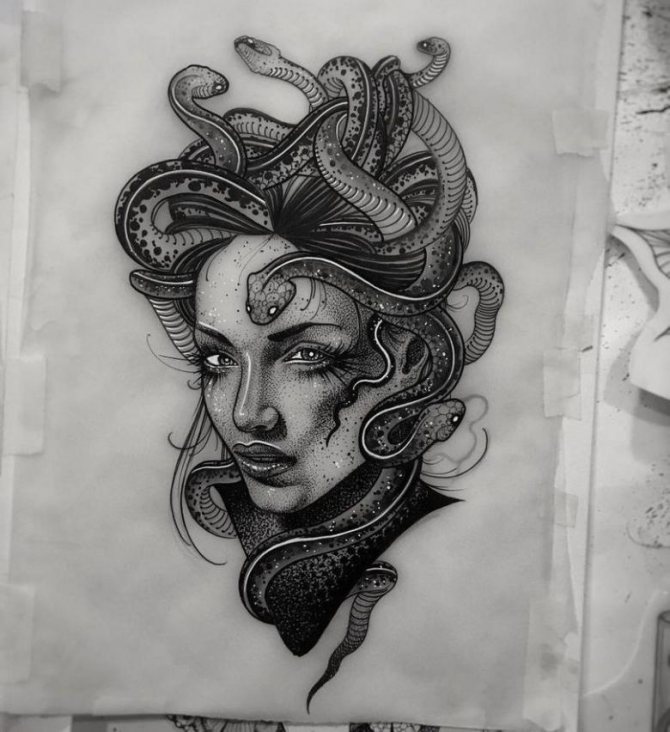

These are the people who are able to set and achieve their goals no matter what. They are ready to destroy everything that will be in their way. Such people like the unknown, the danger. Usually the owners of the natal image of the Gorgon are trying to confront society and to be in the center of everyone's attention.
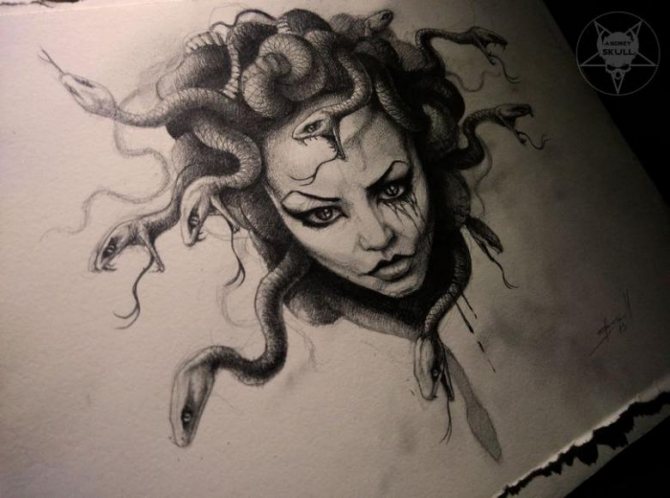

Especially often such a tattoo sketch is chosen by creative people who appreciate aesthetics. The drawing of Medusa looks very attractive and enchanting and fits into modern fashion.
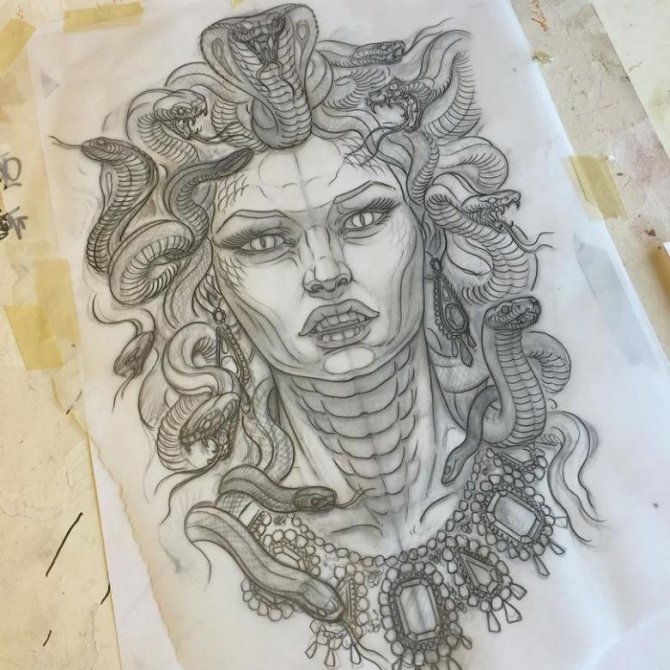

A symbol of the inner fearlessness and courage of a person became a sketch in which Gorgon looks at herself in the mirror. This image symbolizes victory over inner demons. There is even a belief that a tattoo with Medusa becomes a talisman against enemies, ill-wishers and bad deeds. It also scares away all the trouble from its owner.
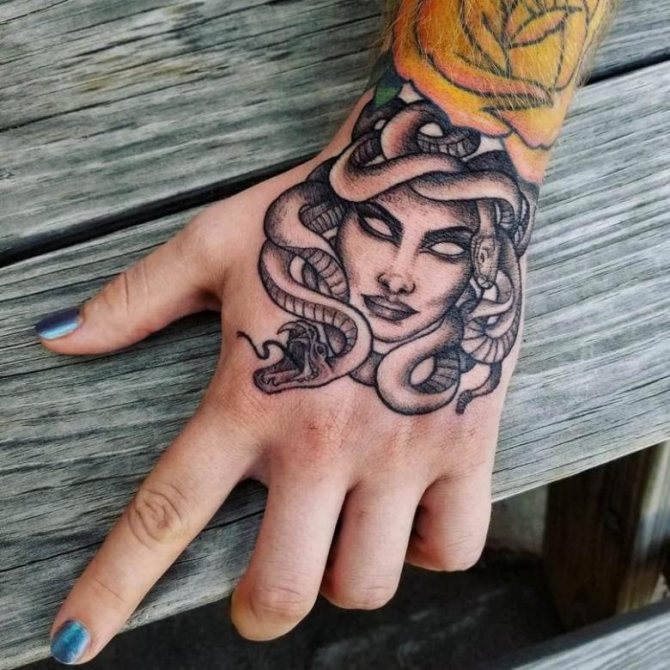

Gorgon Medusa and the curse of the goddess
Medusa was driven to despair by her pursuit of the sea lord. She did not know where to escape the god, who was not nice to her. And so, during another pursuit, the girl decided to take refuge in the temple of Athena.
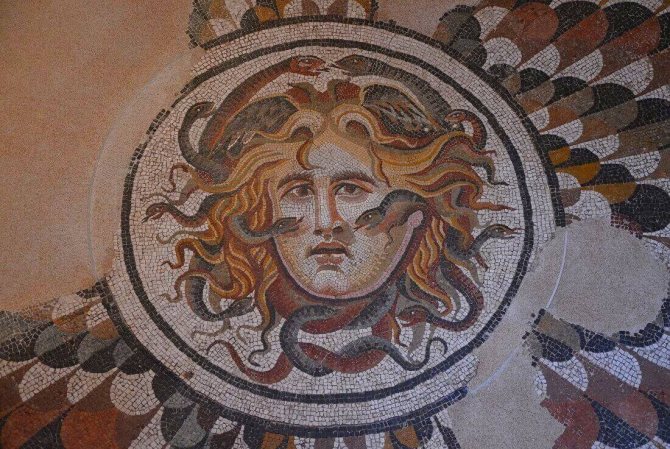

Mosaic floor with Medusa's head I-II century AD, National Museum of Rome, Diocletian's Baths, Rome Photo © Carole Raddato
She thought the sacred place would stop the passion-obsessed Poseidon, but alas, he was not deterred. With his power over Medusa, Poseidon desecrated Athena's altar. Strangely enough, the goddess did not become angry at her "colleague" but directed all her fury at the unfortunate girl.
The enraged Athena turned the beautiful girl into a hideous monster. She grew wings and instead of wonderful hair appeared balls of poisonous snakes. In addition, the goddess endowed Medusa with a deadly gaze - one gaze was enough to turn a man to stone.
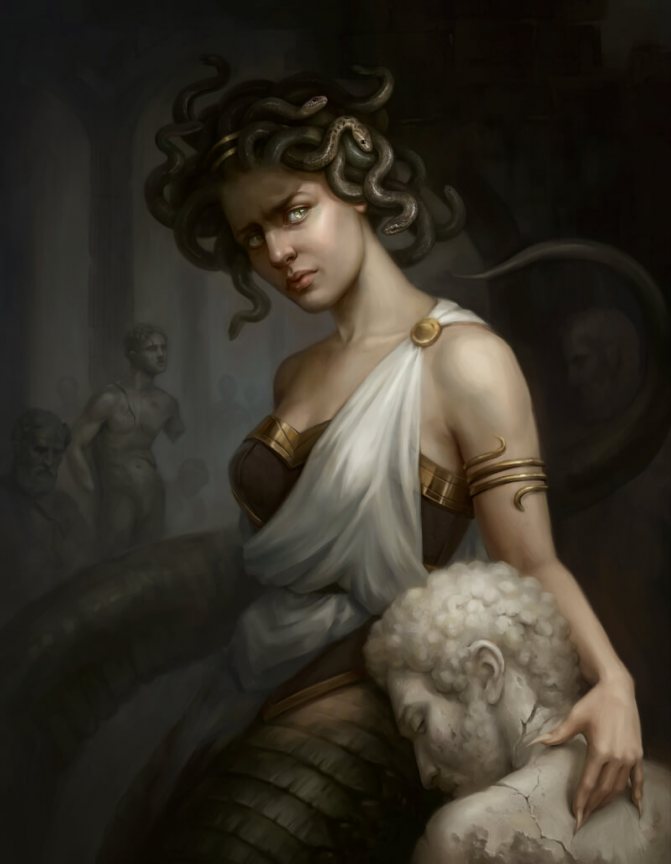

The story of Medusa Gorgon is a tragedy that few people know © Olga Nikityuk / helgengarda.artstation.com
In some myths it is told that all three Gorgons were punished. Trying to escape from human eyes, they moved to a remote island lost in the sea.
In my opinion, it is logical that the resentment and sense of injustice hidden in the souls of unfortunate girls eventually turned into anger and hatred that the "monsters" felt towards mankind and the gods.
Slavic Interpretation
The Slavic goddess Vyrgon had a non-standard appearance with zoomorphic features, the prototype of which was the above-described Medusa. The snake-haired goddess, who understood the languages of all biological beings on Earth, called up once a year with a captivating voice one representative of each living species, who, falling in love with her, died under the influence of her deadly gaze.
Applying an image of Vyrgoni on a snake amulet, the ancient Slavs reckoned that she could protect them from trouble, including illnesses and enemies, who would bounce deadly off the protected person.
The Defeated Monster
We return to the fate of Medusa with the myth of Perseus, which is what made the cursed woman look monstrous. At that point, many centuries had passed since Medusa's conversion, but Athena was still unable to curb her anger. When Prince Perseus is given the task of bringing Medusa Gorgon's head, the goddess of war actively assists him, as well as attracting other gods.
Athena's gift to the hero was a shining shield that resembled a mirror, as well as a magic sickle with which Perseus could cut off the monster's head. The goddess told him about the killing power of Medusa Gorgon's eyes, and on the way Perseus received winged sandals, a magic hat, and a bag for his trophy from the other deities.
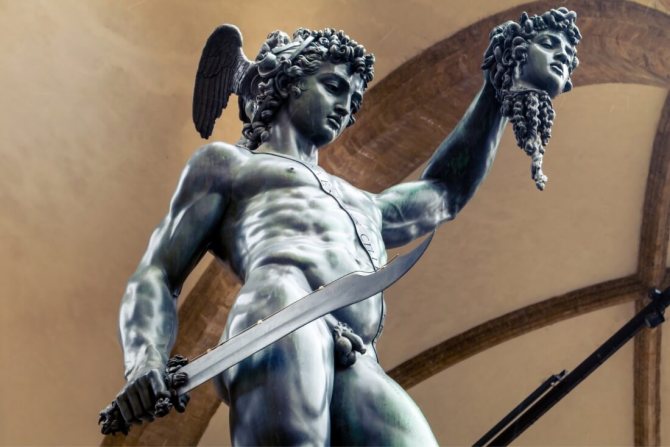

Benvenuto Cellini "Bronze statue of Perseus with the head of Gorgon", 1554 Located in Piazza della Signoria in Florence The statue was created for Duke Cosimo de Medici
As you can easily guess, the hero easily found Medusa Gorgon on the island, taking her down without a fight. Perseus cut off the sleeping monster's head with a gifted sickle. Climbing on winged sandals, the hero dropped a few drops of Gorgon's blood into the sea.
At that moment, mixed with the sea foam, they turned into a beautiful Pegasus - a snow-white horse with wings, the embodiment of power and inspiration. Later, the monster's head, hidden in a sack, served Perseus once more by turning his enemies into stone statues.
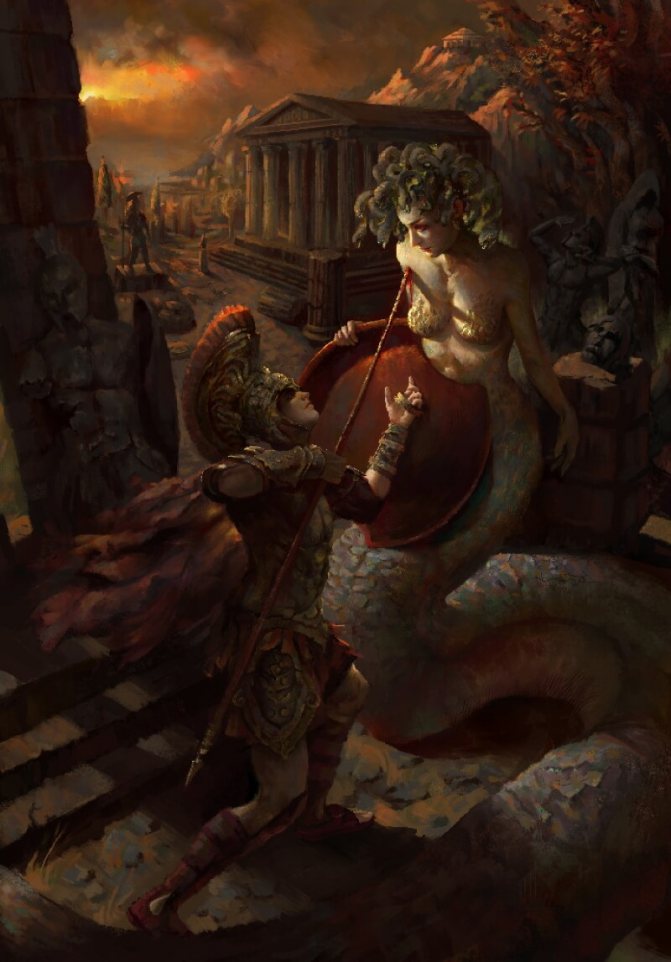

Perseus was able to defeat the Gorgon © Sanjin Halimic / artstation.com
Chernigov hryvnia of Vladimir Monomakh
Discovered by archaeologists in different regions of historical Russia snake catchers belonged to the most common Slavic amulets, which were carried by both the nobility, and the poor strata of the population. If for the latter serpentine were made of cheap materials, the aristocratic medallions used precious metals - gold and silver. A striking example is the large golden "Chernigov Hryvnia of Vladimir Monomakh" found on the bank of the Belous River, probably lost by him while hunting.
Dating back to 1076-94, the medallion traditionally has two compositional components: on the obverse is the image of the patron of Kiev - the Archangel Michael, and on the reverse a female figure, hair, arms and legs which change into a snake head.
Symbols and amulets of Medusa Gorgon
In some retellings of the myths I noticed references to the healing power of Medusa Gorgon's blood. Athena collected it in two different vessels. The blood of the sea maiden could be both poison and medicine.
Only one person, Asclepius, who was revered no less than the gods for his skills, could properly use such an ingredient. Perhaps it was thanks to the blood of the Gorgon that he was able to bring the dead back to life. True, he was severely punished by Zeus.
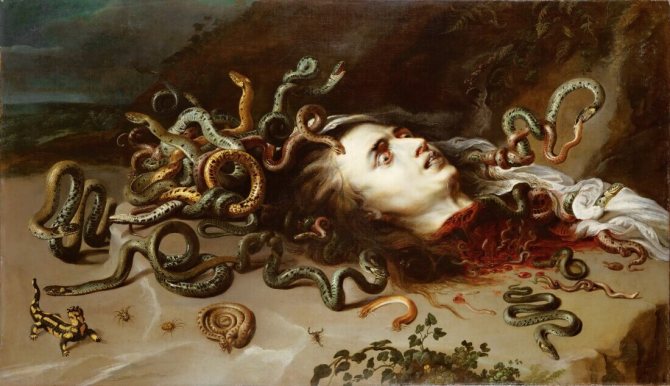

Peter Paul Rubens "Head of the Medusa", ca. 1617 Location: Kunsthistorisches Museum, Vienna, Austria
Ancient depictions of Medusa gorgon are really creepy. A woman's face, framed by snake hair, looks out at us. In the frescoes her eyes seem to be burning or even mad, which is understandable, given the fate of the character.
Despite the deadly power of the Gorgon, people considered amulets with her images as amulets. They were called gorgoneiones. Represented a mask with the face of Medusa Gorgon, which was made of metal or clay, painted on clothing or jewelry.
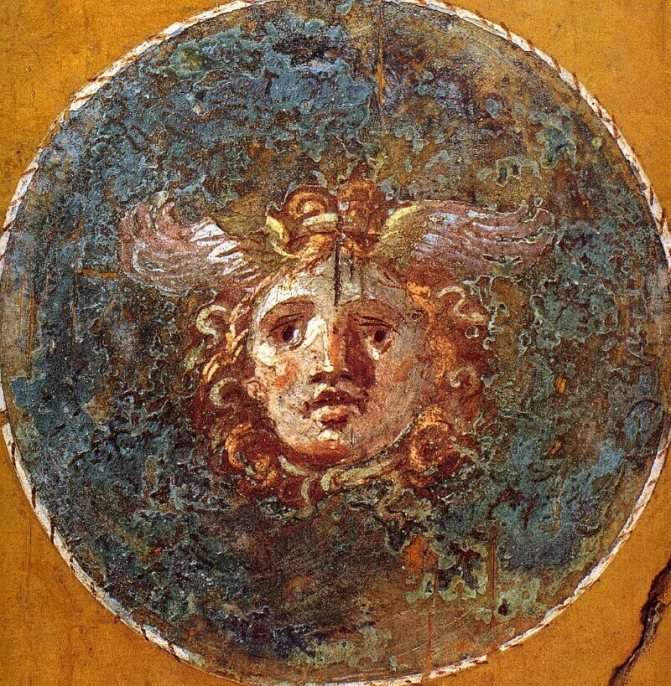

Roman fresco of Gorgon's head in the house of Vettius in Pompeii
What is interesting, Alexander the Great was also associated with the myths of the Gorgon. In ancient times people attributed to him the possession of the magical head of the monster, because the victories of the commander were so brilliant and glorious that it was hard to believe in his human abilities.
Antique images of Macedonian also point to the veneration of Medusa Gorgon. On his armor you can almost always see the head of the sea monster, which was once a beautiful girl.
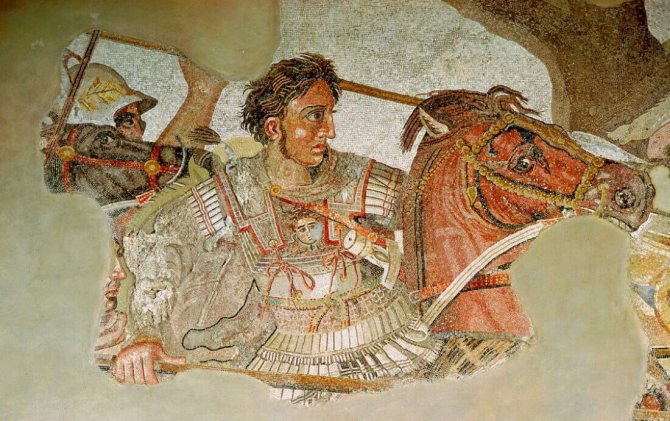

Alexander the Great (Battle of Jesus) on a fragment of an ancient Roman mosaic from Pompeii Location: Naples, National Archaeological Museum
Agree, Medusa Gorgon is worthy of pity rather than the disgust felt for this creepy monster. Unfortunately, the story of her life has remained a minor myth, and the legends of Perseus' victory have gained enormous popularity. Even medieval star charts depicted the ancient Greek hero with the head-trophy in his hands. Today, the face of Medusa Gorgon can be seen on the flag of Sicily, where, according to legends, the beauty who became a monster met her death.
A mascot - serpentine
In Rus, a protective image of a maiden with snake hair or legs was applied to stone or metal medallions, called serpentine. The image depicted on the ancient medallions was very similar to the description of the gorgon Medusa, a colorful character of ancient Greek myth whose name means "protector". The reverse side of these ancient artifacts of round, octagonal or oval shape was decorated with an image of a Christian saint and words from a Greek prayer.
However, if before the baptism of Russia, the front side of the talisman was considered the one on which the image with snakes was embossed, then with the announcement of monotheism everything was officially changed, but people still gave magical precedence to the virgin snake.
In order not to set people against themselves, the church hierarchs did not immediately prohibit this popular pagan symbol, which protected the wearer from disease, the evil eye, epidemics, misfortune and death.
The symbol of the snake, which is suitable for both men and women, could be depicted from 4 to 12 snakes at the same time, and would bestow longevity, health and energy on the wearer. Often the serpentine was kept in the house and guarded it from evil spirits, attracting good luck and prosperity.
A selection of pictures with Trinacria


Ceramic Tile
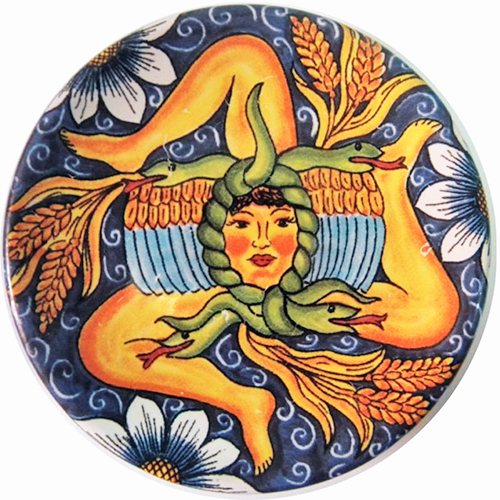

Plate
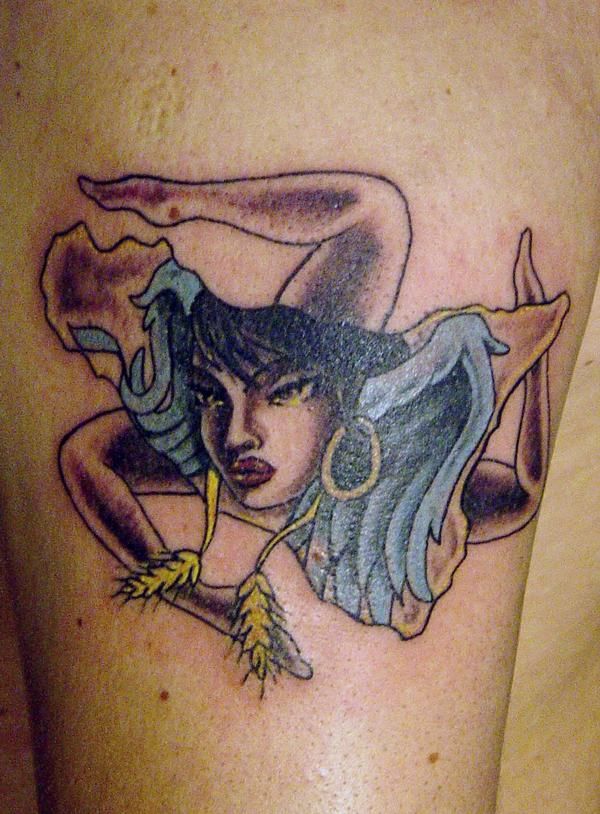

Tattoo with Trinacria
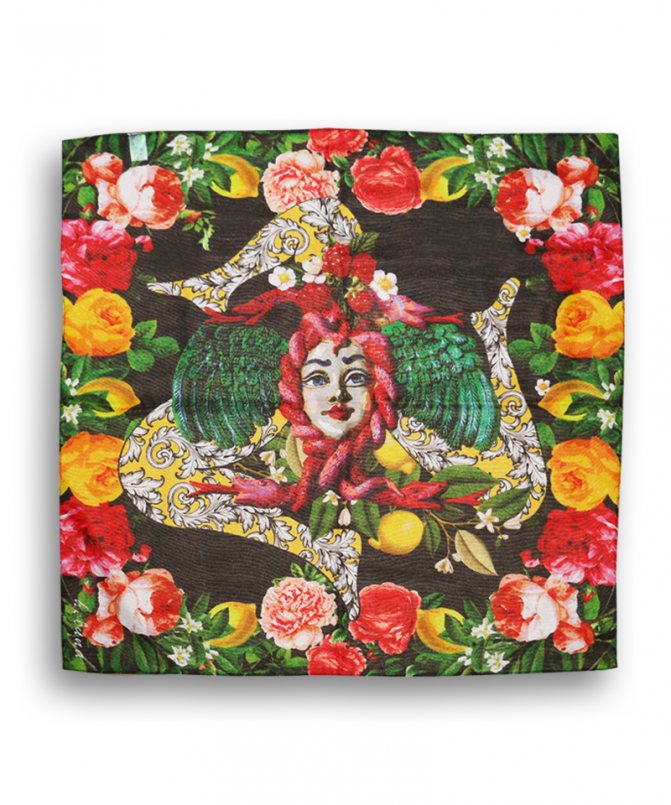

Scarf with Trinacria
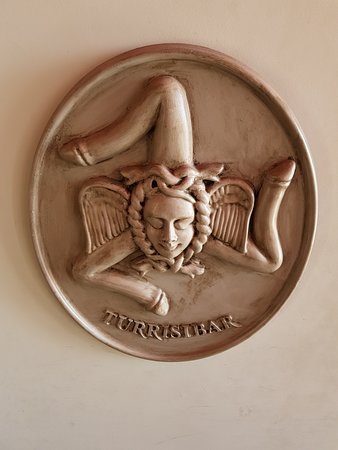

Hmm, cockria? Bar Turrisi, Castelmola.


Trinacria magnet.
Trinacria on the flag of Sicily
Trinacria is on the official flag of the region of Sicily. The flag, whose history begins around the 13th century, was officially adopted by regional law of January 4, 2000 No. 1 and is displayed in all public buildings in Sicily.


The official flag of Sicily
The flag of Sicily is one of the oldest in the world and is a rectangle of two colors with a Triacria in the middle, which symbolizes a strong connection to the history and mythology of the island.
The colors (red and yellow) symbolize the union of the municipalities of Palermo and Corleone during the Sicilian Vespers of 1282.
Scythian roots
The academician Boris Rybakov, having studied the Russian snakes, conditionally divided them into two categories: the first, depicting the head of Medusa gorgon with wriggling snake hair, and the second with the image of the serpentine Scythian goddess Api.
Visually different from the Greek monster the Scythian foremother Api represented the Earth whose serpentine legs symbolized the nourishing underground forces giving rise to new life, which, dying, returned again to the bosom of Mother Earth.
It is no coincidence that on pre-Christian serpents on different sides were carved totem images relating to the veneration of the Earth and the Moon, with the serpent side of such talismans did not have a distinct top and bottom, and was esoteric in nature, embodying the underground Sun.


